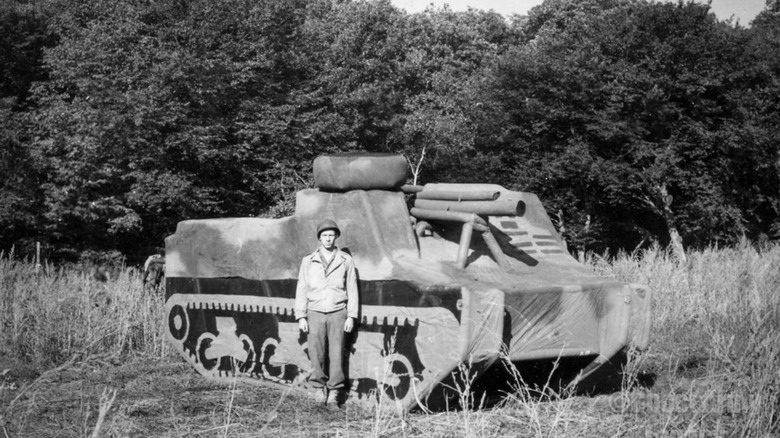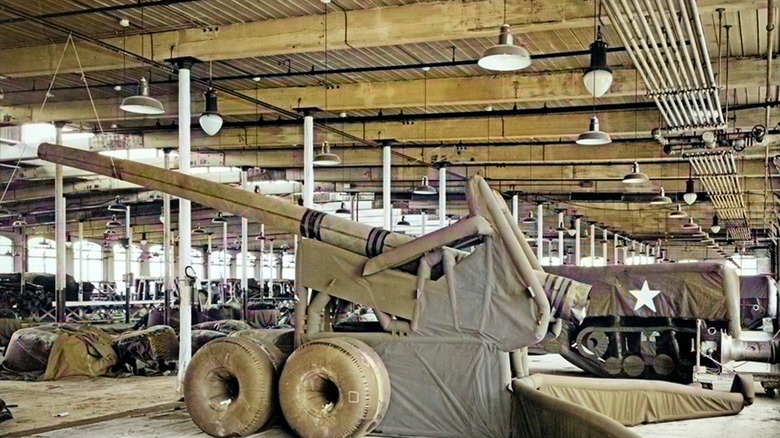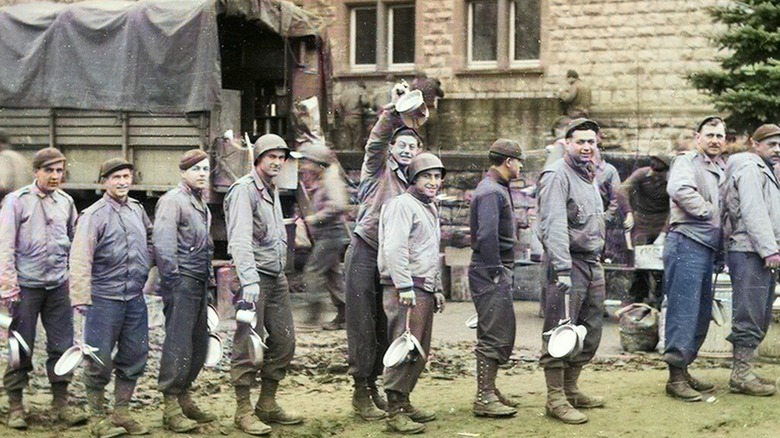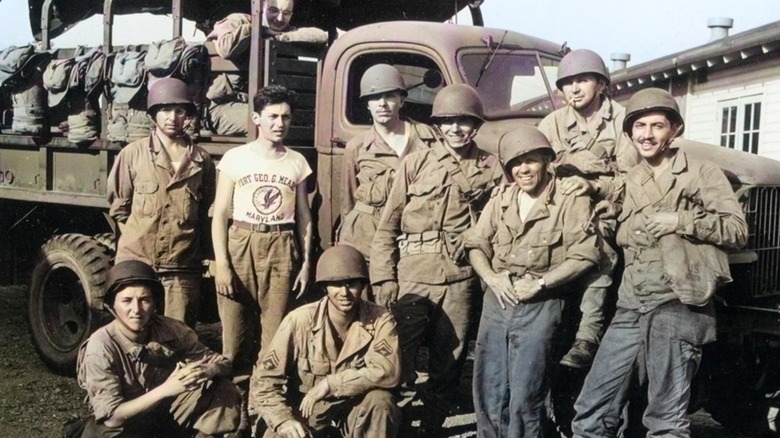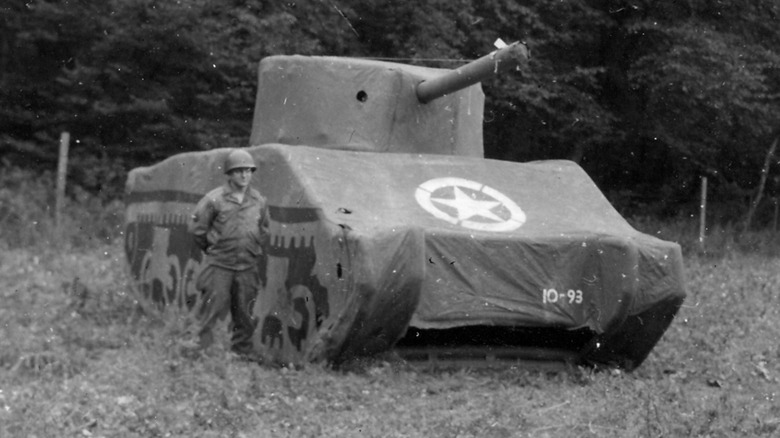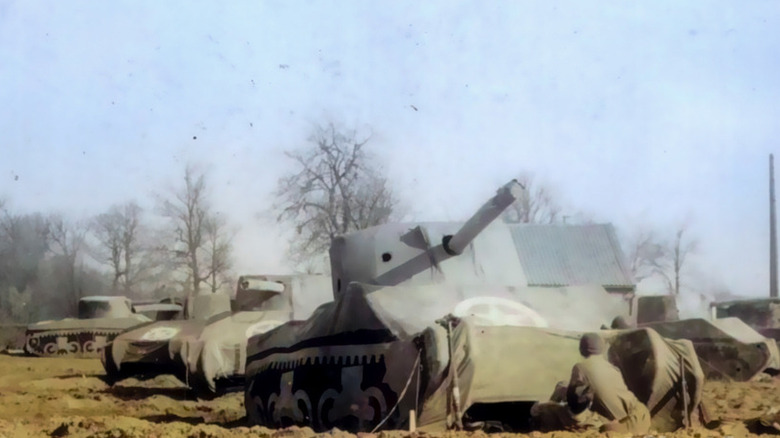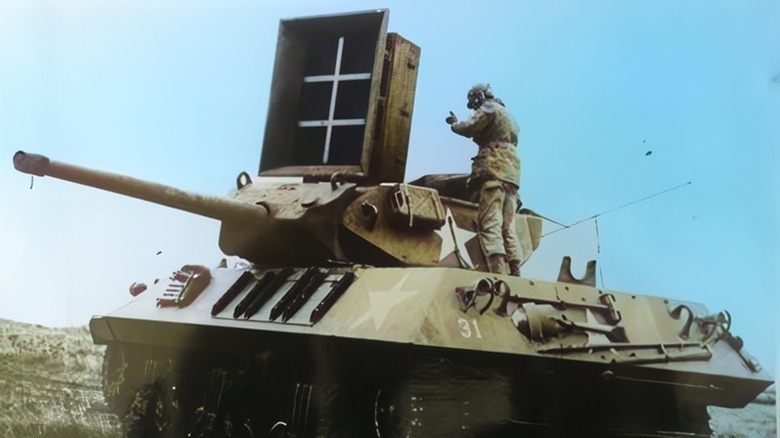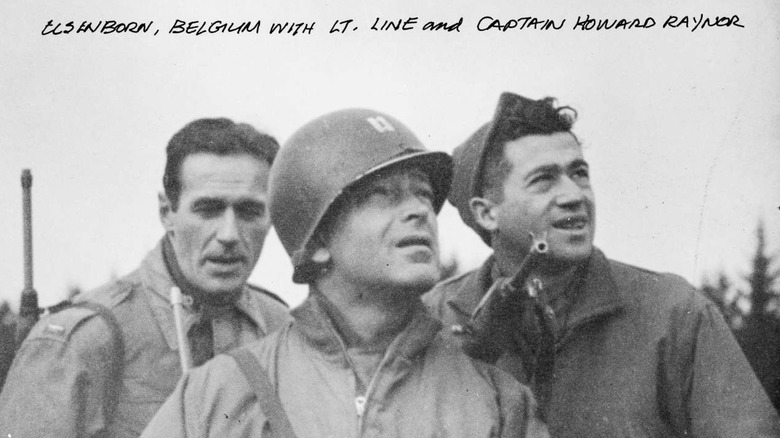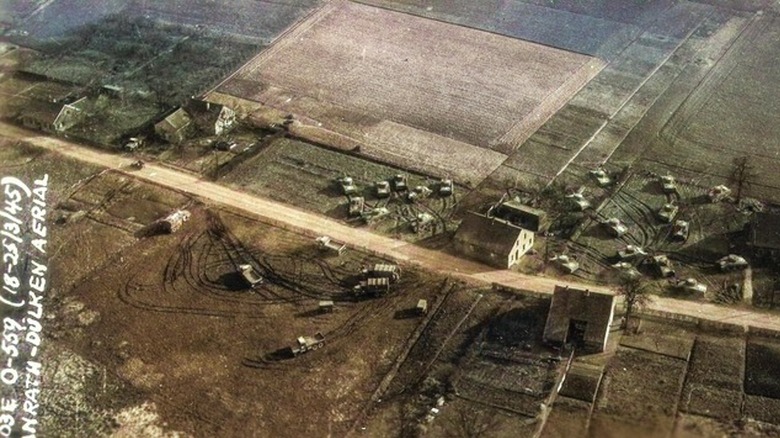The Story Of The Ghost Army's Tank Tricks That Helped Win WWII
Historically, wars have been witness to all kinds of deception. Seeding bad information, tactical concealment, false maneuvers, false demonstrations, and more. One of the most famous is the proverbial Trojan Horse, which is said to have hidden Greek soldiers in its wooden belly and allowed them to win their war against Troy. The art of deception in warfare has trickled down to modern times in various ways. For example, the U.S. Army reportedly blared eerie sounds from speakers during the Vietnam War to affect the morale of enemy soldiers. Irrespective of the form it takes, the end goal is to cast a shadow of superior might over the enemy without necessarily commanding one, or even putting soldiers on the battlefield.
Perhaps the most well-known instance of warfare deception from the U.S. side was the Ghost Army, which worked its magic during World War II. The tale of this battalion is one of courage, ingenuity, and bittersweet recognition. From inflatable tanks to disorientation, the Ghost Army used all manner of devices to deceive its opponents. It was only in 1945 that the U.S. government officially confirmed the deployment of a "ghost army," tasked with tricking the enemy using creative methods like false alarms, inflatable tanks, rubber dummies, and more, according to The New York Times. Interestingly, it was only in 2022 that President Joe Biden gave his nod to a bill that officially recognized the Ghost Army.
The Phantom Group's foundations
Officially known as the 23rd Headquarters Special Troops, the Ghost Army is said to have had close to 1,110 members, which included close to 82 officer posts. According to documents accessed by the National World War 2 Museum, the team had the expertise to mimic the presence of two entire divisions, roughly equivalent to 30,000 soldiers. They employed a combination of visual, sonic, and radio tricks to successfully deceive German forces in the last year of World War II.
The idea of the unconventional, but high-risk, unit reportedly came from Army veterans Billy Harris and Ralph Ingersoll. "I've never met anyone who was such a bright guy who was such a g******ed liar. He'd say anything to get what he wanted," U.S. intelligence officer Went Eldredge was quoted saying about Ingersoll by The Ghost Army Legacy Project. The biggest sub-group in the Ghost Army was the 603rd Engineer Camouflage Battalion, a 379-strong team comprising artists that specialized in cooking up visual deception tools such as inflatable tanks, hollow trucks, fake artillery, and more to trick enemy recon missions.
Then there was the 244th Signal Company, which created false radio signals that aped those from real army wings. The 3132 Signal Service company was tasked with playing troop movement sound effects. The 406th Engineer Combat Company offered real-world protection at the periphery of the 23rd's activities.
A hush-hush existence
The team's formation, as well as their operations, were a closely guarded secret. The activities of the Ghost Army, led by Colonel Harry L. Reeder, were instrumental in saving thousands of Allied lives during World War II, yet they remained shrouded in secrecy for many years post-war. Aside from a solitary newspaper article published shortly after the war, tales of the Ghost Army remained largely undisclosed until they were recounted in an April 1985 Smithsonian Magazine article "A phantom division played a role in Germany's defeat."
While this brought the 23rd Headquarters Special Troops into public awareness, their operations remained officially classified until the late 1990s. According to Smithsonian Magazine, it was around the same window of time in which the original article was published that the U.S. government made the official history of the unit public, as mentioned by the Ghost Army Legacy Project. However, they quickly made these records secret again and remained classified until 1996.
Unique band of recruits
Recruitment for the Ghost Army focused more on creative individuals instead of seasoned war experts. The objective was to harness their intellect to come up with creative plans to fool the enemy with as little direct confrontation as possible. Engineers, artists, illustrators, architects, sound experts, physics, and psychology experts, and more. The only major objective was to recruit men with high IQs. According to the National WWII Museum, the average IQ of Ghost Army members stood close to 119. Among them was fashion designer Bill Blass, who joined the legendary battalion in 1942.
Gilbert Seltzer served as a platoon leader and eventually became a lieutenant and adjutant in the 603rd Engineer Camouflage Battalion, a unit responsible for the visual deception tactics of the Ghost Army. The auditory illusions were managed by the 3132nd Signal Service Company, while the Signal Company, Special, specialized in crafting convincing radio messages to mislead German forces.
The 406th Combat Engineer Company played a crucial role in ensuring the safety and security of these operations. Other well-known members of the Ghost Army include photographer Art Kane, watercolor painter Arthur Singer, and artist Ellsworth Kelly.
The beginning of warfare deception
It was in 1944, just after D-Day, that the Ghost Army landed in France accompanied by trucks loaded with their signature inflatable tanks (roughly 50 of them) and a huge trove of records with different kinds of sound effects, among other deception paraphernalia. Each operation had its very own selection of pre-recorded sound effects, from the rumble of armored vehicles to the sounds of military drills and troop movements. The sound effects were blared from speakers mounted on trucks.
According to History, some of the sound effects could be heard as far away as 15 miles. Across a vast stretch, the team set up fake convoys, false troop divisions, and empty headquarters to parade the "might" of the American army. Their first successful mission was Operation Brittany, which allowed General Patton to reach French land and begin fighting the Germans. A few months later in December, the Battle of the Bulge saw the Ghost Army playing its radio tricks to great success. According to The Chicago Tribune, each speaker weighed as much as 500 pounds.
During a night in July 1944, members of the 603rd found themselves on a farm in Normandy. There, they strategically relocated an antiaircraft battery and substituted it with a rubber replica. By using fake tanks and guns, they created the illusion that the Second Armored Division remained in place, masking its actual movement. Befitting its purpose, the Ghost Army carried out its activities mostly at night.
The tanks which sold the trick
"It was a little bundle of stuff, which our tank was in. Or compress before you open the bundle, spread the nozzles around, and inflate it," said Cpl. Jack Masey in an interview series posted by the Ghost Army Legacy Project (shown below). Crafted with collaborative efforts of American rubber industry giants, these dummies were ingeniously fashioned to project an uncanny semblance of realism when viewed from the vantage point of a distant reconnaissance plane or the towering spires of a remote church.
But it was the speed of deployment that made these inflatable tanks a bigger worry for enemies keeping an eye on enemy movement. "In most cases, like a Sherman tank, we could inflate it and move within 15-20 minutes," recalled Private Joe Spence. In addition to making inflatable copies of the M4 Sherman tank, the team also created bogus air-filled versions of the M7 Priest self-propelled gun.
"Pulling this amorphous shape out of it and watching it fill with air, and taking form. You know, like a monster," another member of the unit was quoted as saying. The near-perfect shape, clean stitching, and intricate painting on these dummies made them seem more realistic than they should have. "That M4 tank was a beauty. That was a piece of work," a Ghost Army member remarked. But it didn't always go according to plan. "If things went very well, there were air compressors. If things weren't very well, there were bicycle pumps. And if things went terribly badly, there were our lungs," described Cpl. Masey.
Their biggest victories
According to a BBC report, the camouflage division of the Ghost Army was once tasked with creating a whole phony army and also creating enough decoys to hide the real army, in just 28 days. The team succeeded. In March 1945, the team staged its most impressive show near the Rhine River in their largest trick yet, dubbed Operation Viersen. This maneuver skillfully redirected the enemy's attention from an actual river crossing by the 9th Army.
"The Ghost Army inflated both 600 dummies and their own size by impersonating two divisions and 40,000 troops," reports History. Their efforts in misleading the Germans about the American 9th Army's Rhine crossing timeline were a huge success, leading to the saving of numerous lives. To sell the idea that they were indeed a part of a much larger army convoy, members of the Ghost Army reportedly hung out at local cafés to seed false information to raise false alarms among enemy spies and stir turmoil among locals.
Even the uniforms they wore had fake shoulder patches to go with the entire facade. Princeton University alumni Fred Fox, who once dreamed of making it big in Hollywood, pulled one such trick after he walked into a bar and came out with seized wine, planting false information among the Germans that the 6th Armored Division had reached the gates.
The Ghost Army's tactical brilliance
One of the earliest public records of the Ghost Army's exploits has been recorded in a story dated November 9, 1943, by The New York Times. It's worth noting that a team tasked with directly deceiving enemy forces armed its members with nothing bulkier than a 0.50 caliber machine gun. "We would move into the woods in the middle of the night, going through France, Belgium, and Germany, and turn on the sound" — from blaring loudspeakers — "so it sounded like tanks were moving on the roads," Gilbert Seltzer, a member of the Ghost Army was quoted as saying by Story Corps in 2019. An architect by profession with a degree from the University of Toronto under his belt, he explained that the natives would think of those sounds as tanks passing through their land. "Imagination is unbelievable," he remarked.
To outsmart the Germans, they camouflaged their tanks, weapons, and supplies to look like trucks. This strategy hid the army's real movements and made the Germans believe the attack would happen from the south and a couple of days later than it did, instead of from the north. A member of the unit said in the documentary that the unit effectively displayed a facade of formidable strength through its deceptive tactics, deterring enemy forces. Additionally, soldiers were not consistently positioned at the front lines, reducing their exposure to danger.
Future of the Ghost Army
For all that it managed to achieve, members of the Ghost Army were concerned about the risks of their mission. In a PBS documentary, a member of the battalion recalled their shocked reaction when they were told by their superiors that their job was to attract the enemy's attention.
However, the most remarkable aspect of the Ghost Army was that it wasn't entirely comprised of field-hardened warfare experts. Instead, it counted among its ranks a healthy number of artists, architects, engineers, deception experts, technical sound wizards, and almost anyone whose skills could lend a helping hand with their acts of warfare trickery. It is, therefore, not a surprise that after their service in the Ghost Army, many members pursued successful careers in various creative fields.
Among them were individuals who became renowned in their respective industries, such as Bill Blass, who emerged as a prominent fashion designer; Art Kane, who gained fame as a photographer; and Ellsworth Kelly, who established himself as a notable painter. Their careers spanned advertising, art, architecture, and illustration, showcasing the diverse talents of these former military artists. According to CBS News, Jack Masey's creative journey led him to design backdrops for the State Department, and among his remarkable creations was the iconic kitchen setting where Nixon and Khrushchev engaged in their historic debate (PDF).
A long road to recognition
According to The New York Times, from June 1944 to the spring of 1945, the 23rd Headquarters Special Troops successfully executed 20 similar operations, which significantly contributed to the preservation of countless American lives. However, some accounts put that number at 22 operations. Despite all its accomplishments beyond the battlefield, the Ghost Army didn't receive official government recognition for decades. These unsung heroes continued their lives without official recognition for their contributions.
However, this changed following a determined campaign spearheaded by Democrat Representative Annie Kuster. Her efforts culminated in the United States government formally acknowledging and honoring the vital role played by the Ghost Army after President Biden signed a bill. But it was quite a bittersweet moment. Most of the members of the Ghost Army had died by the time the U.S. bestowed upon them a Congressional Gold Medal for their valor and duty.
The most recent member of the group to leave the mortal plane was Gilbert Seltzer, who breathed his last late in 2021 at the age of 106. According to The New York Times, he was the oldest surviving member of the Ghost Army and acted as a veteran ambassador for the group. "'Rarely, if ever, has there been a group of such a few men which had so great an influence on the outcome of a major military campaign," an Army analysis concluded about the 23rd Headquarters Special Troops.
